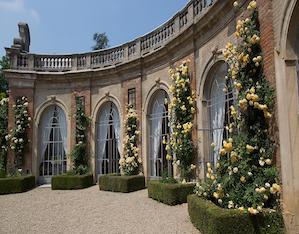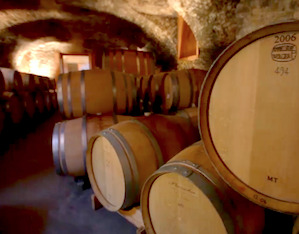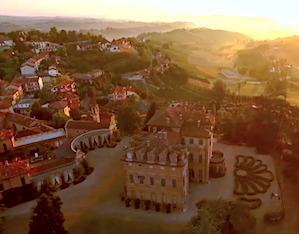 Warning
Warning
Due to the current health emergency situation, visiting times and procedures may be subject to change. It is therefore advisable to check them by contacting the garden directly.
This is a felicitous meeting of centuries-old gardening traditions: the undulating weave of the English-style park Xavier Kurten conceived here offers glimpses of older tastes, such as a set-stealing orangery, crates of citrus fruit, a belvedere over the Tanaro, and the well-pruned shapes of Hornbeam.
Nestling in a hilly landscape between Asti and Alba, this castle originally dates back to the Middle Ages, when it was owned by the Solaro family, important nobles in the Asti area. The Alfieri family took over the property in 1616. Between 1696 and 1721, it underwent major refurbishment to become an elegant baroque residence. In the 18th century, the park was re-arranged into a formal French-inspired design. It was broadly revised when Kurten redesigned it as a landscaped park in 1815, on what in all likelihood was the German architect’s first job in Piedmont; he had come to Turin during the Napoleonic period, when Marquis Carlo Emanuele Alfieri di Sostegno was Savoy Ambassador. Centuries-old specimens of exotic species, including a rare
Highlights

Hemicycle-shaped Greenhouse
The north-eastern portion of the castle site features an elegant hemicycle-shaped orangery – a remnant of the formal eighteenth-century design by architect Benedetto Alfieri – which still shelters specimens of citrus fruits grown in pots.

An Ancient Winery and its Fine Wines
From the annals of families that have come and gone over the centuries, records of lands in San Martino Alfieri being described as “vineati a philari” date back to 1337. This centuries-old wine tradition is still being celebrated here today: wines are aged in barriques in the old cellar beneath the orangery.

Monferrato and its Surroundings
San Martino Alfieri lies in the fertile lands of Monferrato, an area of great food and wine routes for discovering Piedmont’s culinary excellence, as well as excursions into the hills and villages of Monferrato, including the nearby castles of Govone and Cisterna d’Asti.
 Castello di San Martino Alfieri
Contacts
Castello di San Martino Alfieri
Contacts
Contacts
Telephone:+39 0141976015
Address
Piazza Alfieri, 28
14010, San Martino Alfieri (AT)
 Castello di San Martino Alfieri
Opening times and prices
Castello di San Martino Alfieri
Opening times and prices
Opening hours
Opening hours: 8.30 – 12.30 / 14.00 – 18.00. Saturday and Sunday by appointment only. Guided tours and wine tasting by appointment only.
Pricing
The visit includes the historic cellars, theorangery, the castle park. It is possible to organise a tasting of the company’s most representative wines. To know the various rates we suggest to contact the garden directly.
 Castello di San Martino Alfieri
How to get there
Castello di San Martino Alfieri
How to get there
Address
Piazza Alfieri, 28
14010, San Martino Alfieri (AT)
Latitude: 44.817051
Longitude: 8.109043
How to arrive by road
From Milano/Milano Malpensa, Torino:
A21 Torino-Piacenza motorway. Exit at Asti Est. Continue in the direction of Alba on the A33 (Asti-Cuneo). Exit at Isola d’Asti and continue in the direction of Alba on the SS231. After 4.5 km, in the village of Motta di Costigliole, turn right at the traffic lights onto the SP41 for San Martino Alfieri and follow the signs for the winery. The Marchesi Alfieri winery is located in the castle in the town centre.
From Alba:
Take the A33 motorway (Asti-Cuneo) in the direction of Asti. Exit at Costigliole/Govone. Continue on the SS231 in the direction of Asti. After 2 km, in the hamlet of Motta di Costigliole, turn left at the traffic lights onto SP41 for San Martino Alfieri and follow the signs for the winery. Marchesi Alfieri is located in the castle in the centre of the village.
 Castello di San Martino Alfieri
Services/Accessibility
Castello di San Martino Alfieri
Services/Accessibility
Services
Every day, by appointment, guided tours of the historic cellars, the citronera, the castle park and tastings of the company's most representative wines. The tasting room and the Baroque Orangery can accommodate small groups of enthusiasts with a personalized welcome according to individual needs.
Pets are allowed upon request to the property.
The estate offers free wi-fi to guests of the property.
Accessibility
The estate has a room for the stay of disabled people and a reserved parking.
 Castello di San Martino Alfieri
Private events
Castello di San Martino Alfieri
Private events
 Castello di San Martino Alfieri
Itineraries
Castello di San Martino Alfieri
Itineraries
 Favorite saving result
Favorite saving result
 Warning!
Warning!
You've have to sign up or sign in to add this element to your favorites.
